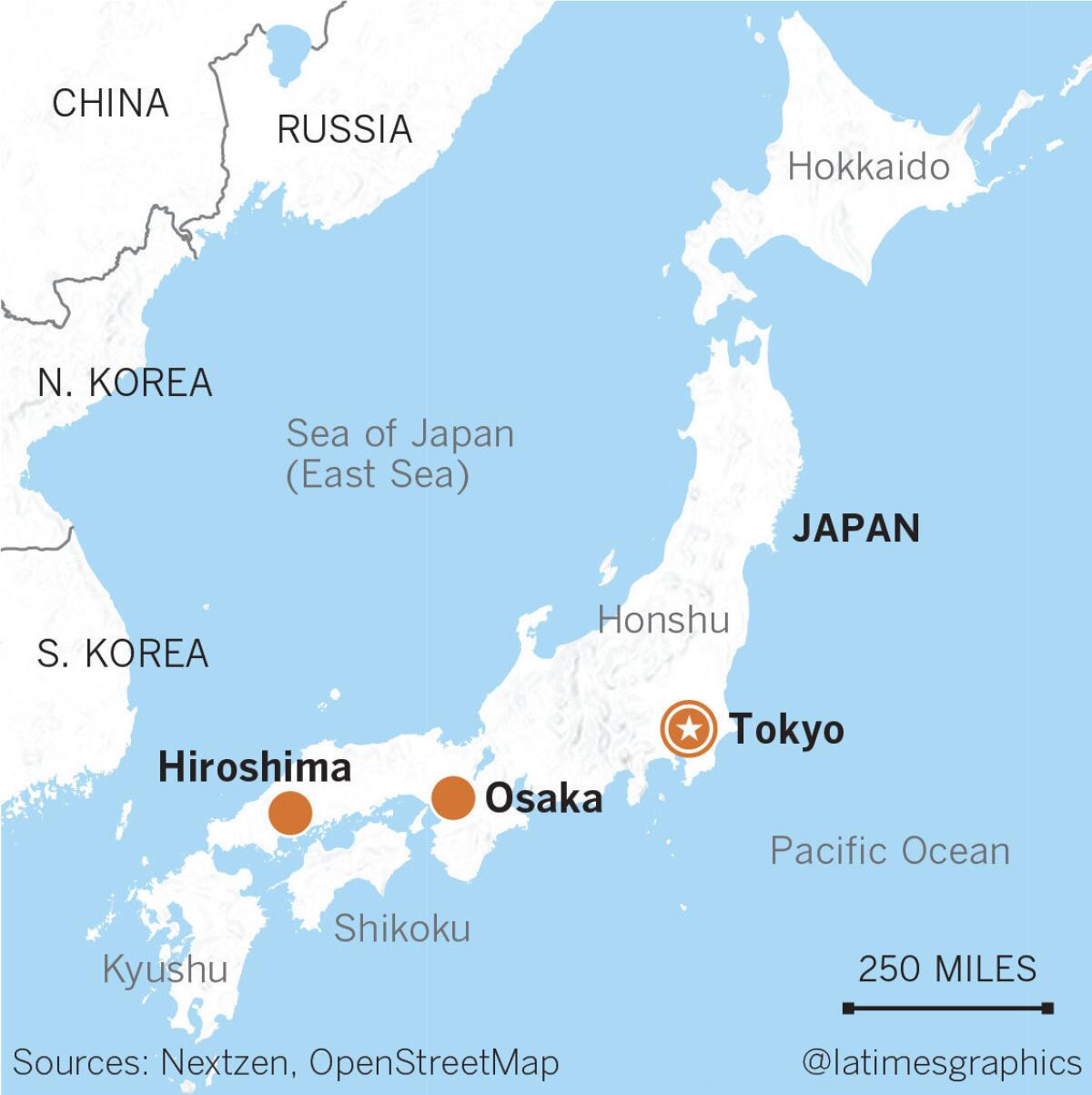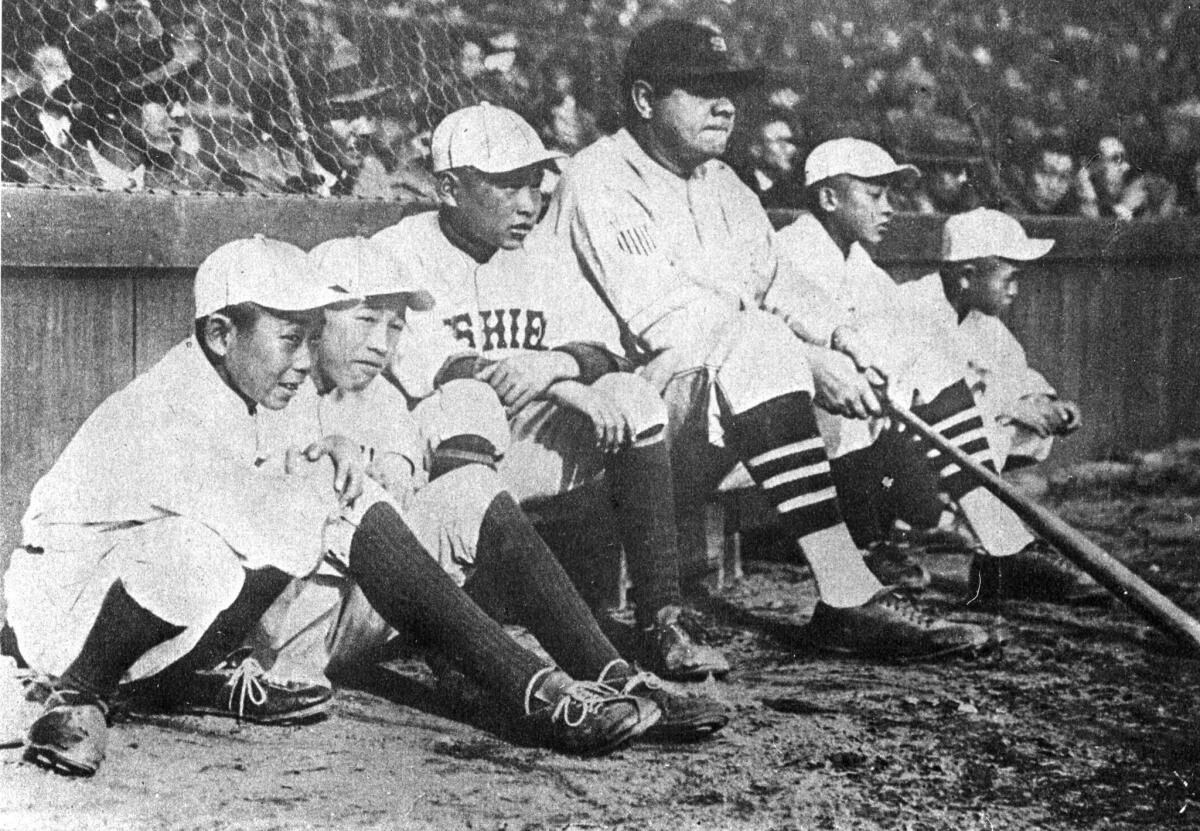A baseball trip through Japan is just what a jaded MLB fan needed
Reporting from Tokyo — Another Major League Baseball season is right around the corner, and some of us already are dreading another mediocre Angels season or the same old Dodger dogs.
If you’re looking to rekindle your passion for Major League Baseball, the answer may be 6,000 miles away in beautiful Japan, where Nippon Professional Baseball, the country’s highest level of pro ball, will have you viewing America’s pastime in a whole new light.
I set out in July for the Land of the Rising Sun to see whether I could cure my baseball blues. NPB did not disappoint, as the second-most-competitive league in the world behind MLB. Nippon baseball’s brightest stars, among them Hideo Nomo and current phenom Shohei Ohtani, have often shone in the U.S.
The caliber of play is impressive, but NPB’s unique rituals, enthusiastic crowds and flavorful food make it a must for any sports fan.
Crosstown Rivals
I started my journey in Tokyo, setting out for Jingu Stadium, less than half an hour by train from Shinjuku Station. (English is used throughout Tokyo’s transit system, making travel a breeze.)

The small ballpark, built in 1926, hosted Babe Ruth during his 1934 barnstorming tour and is now home to the Yakult Swallows, a lovable squad that plays in the shadow of its more popular crosstown rival, the Yomiuri Giants.
The energy at the stadium was fantastic from start to finish. The sold-out crowd cheered their hearts out, chanting songs and banging drums in honor of each batter. Per tradition, the fans performed the umbrella dance, raising their umbrellas in unison while singing an upbeat J-pop song each time the Swallows scored.
Perhaps most surprising: Japanese baseball fans did not stare at their smartphones during the game or mill about the stadium looking for distractions. A particularly enthusiastic young boy next to me remained seated for all nine innings, cheering, singing and even offering me a few of his squid snacks.
There was no booing or yelling at the umpires — even when a call was reversed against the home team — and the crowd roared in delight when a batter laid down a perfect sacrifice bunt.
The Big Egg
A few days later, I traveled across the city to watch the Giants host the Yokohama DeNa BayStars at the Tokyo Dome, which locals call “The Big Egg.”
The stadium is much larger than Jingu, seating nearly 20,000 more fans, and offers some of the most bizarre yet enticing food items I have seen in a ballpark. The bento boxes and fresh sushi were delicious, but you’ll want to save yourself for an outlandish option, such as a hot dog covered with nachos, roast pork, mayo and lemon curd or tuna mayo, among the crazy toppings.
Don’t be intimidated: It’s all delicious.
Phu Quoc, Vietnam, wasn’t the paradise of memory. The culprit? Climate change »
When NPB fans are thirsty, they don’t have to wait long between drinks. “Beer girls” roam the stands with kegs strapped to their backs, eager to dispense cheap draft beer — or, in some cases, highballs — to anyone in need of a refill. I wondered why MLB hadn’t thought of this.
As an added bonus, Japan’s Baseball Hall of Fame and an amusement park are around the corner from the Tokyo Dome, making a Giants game a terrific way to spend a day.
Bullet Train West
No trip to Japan is complete without a ride on the bullet train, which whisked me 400 miles across the countryside to Osaka, the charming big city known for its exquisite food, picturesque castles and, of course, die-hard baseball fans.
The Hanshin Tigers are the most popular team in the area, playing in Koshien Stadium, about a half-an-hour train ride from Osaka. The ballpark, built in 1924 and modeled after Wrigley Field, was visited by the Babe in ’34, and a museum within the stadium commemorates this moment.

But you’ll quickly forget about Babe Ruth, and MLB in general, when you start watching the ballgame. Fans wearing tiger-striped fedoras will surround you, chowing down on okonomiyaki (a savory pancake filled with pork, oysters, noodles and much more) and other local delicacies as they cheer for the home team.
One man in the front row proudly wore a tiger mask and danced all nine innings, leading chants while gyrating wildly. During the seventh-inning stretch, fans blew up red and yellow balloons, waving them as they sang an up-tempo fight song.
Why Asia? Why now? Here’s why, from a writer who now calls it home »
I was entranced as the crowd released the balloons, a stream of yellows and reds winding through the night sky and, for a few minutes, I felt like a kid again.
Historic Hiroshima
I continued my journey west to the final stop, Hiroshima, a city steeped in history. The museums and attractions keep visitors occupied, but locals are focused on their beloved Hiroshima Toyo Carp. It’s the only community-owned team in NPB, and it shows. You cannot walk more than a few feet in Hiroshima without seeing Carp flags, ornaments and street art.
The team had to cancel the homestand because of deadly flooding that plagued western Hiroshima last summer, but I still visited the Carp’s home — Mazda “Zoom Zoom” Stadium — and checked out its team store. I was particularly amused by the Carp’s primary logo: a giant C, very similar to that of the Cincinnati Reds.
At this Beijing hotel, guests learn the art of shadow puppetry »
Around the horn
I felt like a changed man on my flight back to the States. I had visited a baseball wonderland, a hardball utopia where rival fans were fervent yet amicable, food was fresh and exotic, and wild, singsong cheers were as much a spectacle as the game itself. MLB, eat your heart out.
Did Japan completely cure my baseball malaise? I was on the road to recovery.
If you go
THE BEST WAY TO TOKYO
From LAX, JAL, American, All Nippon, Singapore and United offer nonstop service to Tokyo, and American, United, Delta, Asiana, Air Canada and Hawaiian have connecting service (change of planes). Restricted round-trip airfare from $747, including taxes and fees.
THE BEST WAY TO BUY BASEBALL TICKETS
Visit JapanBall, a trustworthy site where you can buy tickets and have them delivered to your hotel concierge or Airbnb. Prices vary but start at about $17 per ticket. Or use the site to book a complete Japanese baseball tour, starting at $1,085 per person (does not include airfare and most meals). Tickets are also available at Japanese convenience stores and at the stadiums on game day, but go early because they often sell out.
THE BEST WAY TO TRAVEL BY BULLET TRAIN
Japan Rail Pass, offers unlimited access to the Shinkansen bullet train for seven, 14 or 21 days, starting at $262 for a seven-day pass.
WHERE TO STAY
Hotel Sunroute Plaza Shinjuku, 2-3-1 Yoyogi, Shibuya-ku, Tokyo. Small rooms in the heart of Shinjuku with easy access to public transportation. Doubles from about $147 a night.
Hotel Monterey Osaka, 3-3-45 Umeda, Kita-ku, Osaka, Japan. A cozy European-themed hotel minutes from local train stations. Doubles from about $108 a night.
Mitsui Garden Hotel Hiroshima, 9-12 Naka-machi, Naka, Hiroshima, Japan. Elegant hotel a few blocks from the A-Bomb Dome and Peace Memorial Park. Doubles from about $122.
WHERE TO EAT
Manten Sushi Marunouchi, 2 Chome-6-1 Marunouchi, Chiyoda, Tokyo. An exquisite, 24-course omakase sushi dinner reasonably priced at $53 per person.
Bella Bocca, 1-3-13 Shibata, Kita-ku, B1 Shibata Bldg., Osaka, Japan; bella-bocca.com An organic Italian restaurant with a Japanese twist. Enjoy ginseng sauce spaghetti, carbonara pasta, fresh garden salads and more. Small plates and entrees $8-$35.
Okonomi-mura, 5-13 Shintenchi, Naka-ku, Hiroshima Prefecture, Japan. A large food court featuring 24 restaurants specializing in okonomiyaki, a savory pancake. Each restaurant makes the dish using its own ingredients, including mochi cheese, kimchi and fresh Hiroshima oysters. Prices start at about $6.
TO LEARN MORE
Japan National Tourism Organization
A Brief History of Japanese Baseball
More to Read
Sign up for The Wild
We’ll help you find the best places to hike, bike and run, as well as the perfect silent spots for meditation and yoga.
You may occasionally receive promotional content from the Los Angeles Times.







